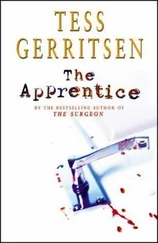“What you’re looking at,” said Dr. Cherry, “is called lamellar or Damascus steel. It forms this wavy pattern when different layers of metal are folded and hammered again and again, sandwiching together both soft and hardened steel. The more layers you see beaten together, the finer the workmanship, and the stronger the sword. In China, the best steel is called bailian jinggang , or ‘hundred-times-forged steel.’ And that produces these patterns you see here, which we call the blade’s veins.”
“If this is a Chinese weapon,” said Frost, “why is it called Damascus steel?”
“To explain that, I have to tell you a little about the history of Chinese weaponry. That is, if you want to hear it.” He paused, glancing at the three detectives to gauge their interest.
“Go on,” said Jane.
Dr. Cherry’s eyes lit up, as if there was no subject he enjoyed more. “Let’s go back to the beginning of swordcraft. Thousands of years ago, the Chinese started off making blades out of stone. Then they progressed to bronze, a soft and heavy metal that has its limitations as weapons material. The next advance was iron, but we don’t find many examples of those swords because iron corrodes, leaving very little behind. Ironically enough, you’re more likely to come across a bronze sword than an iron sword, even though bronze is centuries older.”
“But we’re talking about steel here,” said Tam. “Not iron.”
“And do you know the difference between steel and iron?”
Tam hesitated. “If I remember right, it has something to do with the addition of carbon.”
“Very good!” Dr. Cherry beamed. “Not everyone knows that, not even some of my freshman students at Harvard. So now we’re into the middle Han dynasty, about two thousand years ago, when sword-makers learned to forge and fold steel, to hammer it into bands and sheets. The technique probably originated in India and later spread to China and the Middle East. And that’s how it got the name Damascus steel.”
“But it’s not from Damascus at all,” said Frost.
“No, it’s originally from India. But good ideas are bound to spread, and once the technique reached China, swordmaking truly advanced to an art. As the centuries passed, their technical quality varied, depending on the state of warfare. With every new conflict, weapons always evolve. When the Mongols invaded during the Song dynasty, they introduced sabers. The Chinese adapted that saber into their own curved sword. It’s known as the dao , and it was used by cavalry to cut and slash while on horseback. We’re talking about blades that were razor-sharp, so you can imagine the carnage on the battlefield. There would have been mass dismemberment and decapitation.”
It was a gruesome image that Jane could picture only too vividly. She remembered the alley. The whoosh of the blade, the spray of hot blood on her face. The gentleness of Dr. Cherry’s voice grotesquely underplayed the horror of what he was describing.
“Who the hell would sign up to be a soldier? Not me,” said Frost.
“You might not have a choice,” said Dr. Cherry. “For much of ancient history, armed conflict was part of life in China. Warlord pitted against warlord. Invasions by Mongols and pirates.”
“Pirates? In China?”
Dr. Cherry nodded. “During the Ming dynasty, Japanese pirates terrorized the Chinese coast. Then a hero named General Qi marched in and defeated them.”
“I remember hearing about him,” said Tam. “My grandmother told me that General Qi cut off the heads of five thousand pirates. His adventures made great bedtime stories.”
“Geez,” muttered Jane. “To think all I got was Snow White and the Seven Dwarfs.”
“General Qi’s elite soldiers were renowned for their ingenious tactics,” said Dr. Cherry. “And their weapon of choice was the dao . The Chinese saber.” He pointed to the magnified image on Erin’s computer screen and said, with a note of awe: “It’s amazing to think that’s what this fragment probably came from.”
“A Chinese saber?” said Jane.
“Yes.”
“How can you tell, from that little piece? Couldn’t it be from a Japanese samurai sword?”
“That’s possible, I suppose, since the Japanese learned their swordmaking techniques from the Chinese.”
“And samurai swords are easy to find,” said Tam. “You see them for sale in specialty knife stores.”
“Ah, but those stores don’t sell swords like this one.”
“What’s so special about it?” asked Jane.
“Its age. Based on carbon-fourteen dating.”
Jane frowned. “I thought carbon-fourteen dating was only used for organic material. This is steel.”
“Let’s go back to how ancient swords were made,” said Dr. Cherry. “The traditional technique was to melt iron sand in a forge. That iron was then combined with carbon to form steel. But where do you get the carbon? They used wood ash.”
“And wood is organic,” said Tam.
“Exactly. We extracted the carbon component of this specimen using sealed-tube combustion,” said Erin. “And that carbon was then analyzed.”
“The fragment had to be destroyed?”
“Unfortunately, yes. To date the carbon, the specimen had to be sacrificed. It was the only way we could get an accurate age.”
“And that’s where the big surprise came in,” said Dr. Cherry, a lilt of excitement in his voice.
“I take it this weapon wasn’t bought in some local knife store,” Jane said.
“Not unless that store deals in very old antiques.”
“How old are we talking about?”
Dr. Cherry pointed to the micrograph. “That steel you see there was crafted during the Ming dynasty. Carbon-fourteen dating narrows it down to sometime between the years 1540 and 1590.” He looked at Jane, his eyes aglow. “That just happens to be the era of General Qi’s legendary army. A saber with this degree of craftsmanship could have been wielded by one of his elite soldiers. Maybe it even cut off the heads of a few pirates.”
Jane stared at the image on the computer. “This weapon is over five hundred years old? And it’s still usable?”
“It’s possible to preserve such a sword for a long, long time, but it takes special care, especially if this weapon actually saw use on the battlefield. Blood corrodes steel, even if it’s assiduously wiped away. Exposure to air causes rust and pitting. The blade would need repeated cleaning and polishing over the centuries, and that alone abrades the metal, making the cutting edge brittle. That may be why this particular blade chipped off in the victim’s neck. It’s simply reached the end of its useful life as a killing tool.” He gave a wistful sigh. “What I’d give to examine it! A dao from General Qi’s era would be priceless, if you could just find it.” He paused and frowned at Frost, who had suddenly paled. “Is something wrong, Detective?”
Frost said, softly: “I know where to find that sword.”

ONCE AGAIN, DETECTIVES RIZZOLI AND FROST HAVE INVADED MY studio, and this time they’ve brought along a well-dressed black gentleman whose soft-spoken diffidence indicates that he is not a policeman like them. The sudden interruption startles my class, and the dozen students stand frozen, their sparring exercises abruptly halted. Only Bella strides into action, slipping past the students to plant herself beside me. She acts as my fierce guardian, all five foot, four inches of her, including her spiky black hair. I am not surprised to see the visitors, and I cast a glance at Bella that says: Stand down. Allow me to deal with this .
Читать дальше













